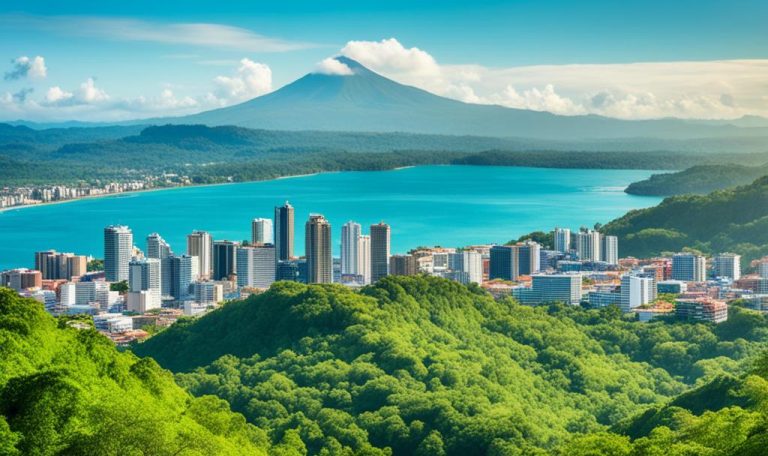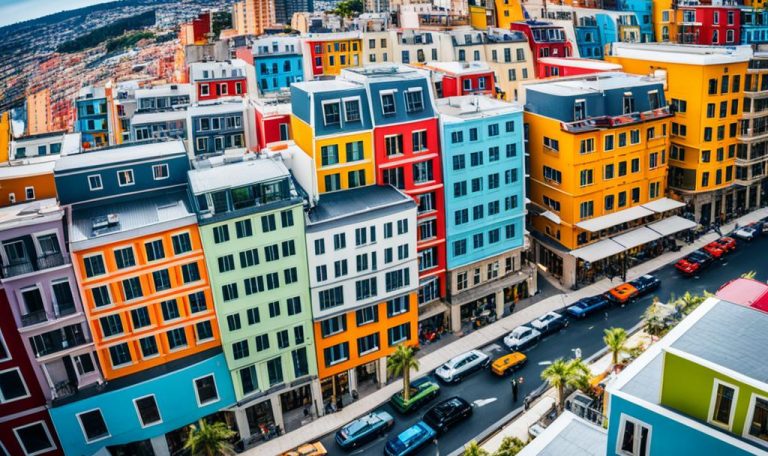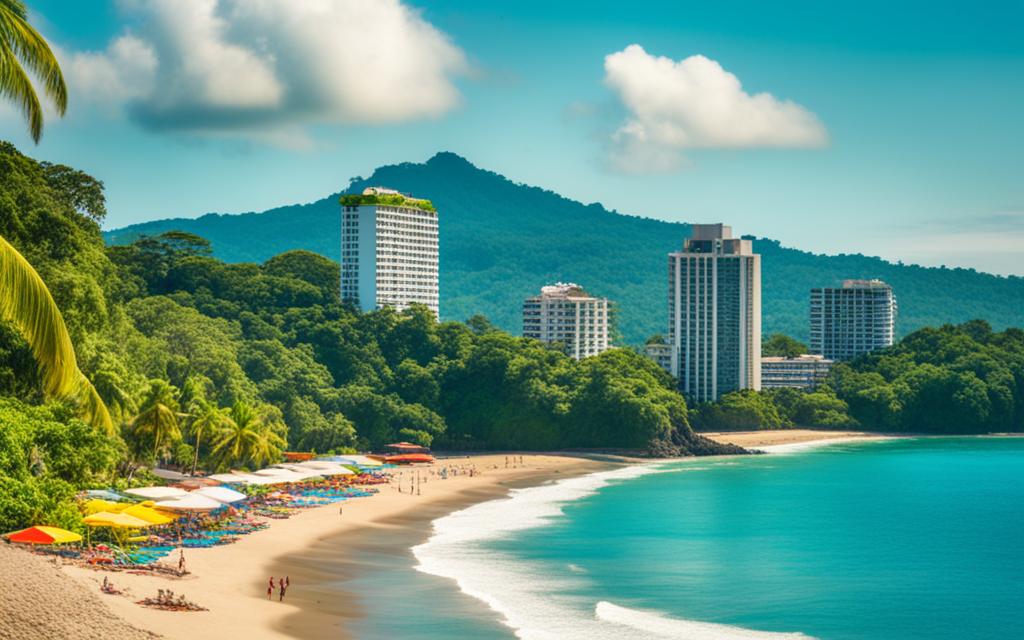Costa Rica is known for its beautiful nature and eco-tourism. In recent years, it has seen a big increase in tourists. The Costa Rican Tourism Institute (ICT) reports that over 1.5 million visitors came in the first half of 2024. This is a 14.5% jump from the year before.
This rise in tourism has caused big problems for the housing market, especially in places popular with tourists.
Key Takeaways
- Costa Rica’s tourism industry has experienced a substantial boom, with a 14.5% increase in visitor numbers in the first half of 2024.
- The rapid growth in tourism has led to a housing crunch, with rent and land prices soaring in popular tourist areas.
- This has made it increasingly difficult for locals to access affordable housing, forcing many to relocate.
- Sustainable tourism strategies and government initiatives are needed to balance economic growth and local community needs.
- The “Airbnb effect” and the rise of vacation rentals have further exacerbated the housing shortage in certain regions.
Introduction to Costa Rica’s Booming Tourism Industry
Costa Rica’s tourism has grown a lot in recent years. It’s now a top spot for those who love nature, adventure, and culture. This growth has helped the country’s economy a lot, creating many jobs and boosting its wealth.
Exploring the Rapid Growth of Costa Rica’s Tourism Sector
In the last ten years, more and more people have visited Costa Rica. In 2019, a record 3.1 million tourists came before the COVID-19 pandemic hit. The country is known for being green and offering many activities like hiking, wildlife watching, and beach relaxing.
This tourism boom has greatly helped Costa Rica’s economy. It makes up over 5% of the GDP and gives jobs to thousands. Many families in rural areas depend on tourism for their income.
| Year | Tourist Arrivals | Tourism Revenue (in millions USD) |
|---|---|---|
| 2015 | 2.66 million | $3,281 |
| 2017 | 2.99 million | $3,810 |
| 2019 | 3.13 million | $4,125 |
The table shows how tourism in Costa Rica has grown. It highlights the big role it plays in the economy.

With tourism on the rise, Costa Rica must tackle challenges. These include the impact on housing and finding affordable places for locals to stay.
Record Tourism Numbers Challenge Costa Rica’s Local Housing Market
Costa Rica’s tourism has brought big economic benefits. But, it has also created a big challenge for the local housing market. The number of tourists and foreign investors has increased vacation rentals and homes. This has led to a shortage of housing for locals.
In places like Guanacaste, the demand for vacation rentals has gone up a lot. This has made rent and land prices very high. It’s now hard for locals to afford homes because of the vacation rental industry and foreign buyers.
This trend has two big effects. It makes housing less affordable for locals and challenges Costa Rica’s tourism. If locals can’t afford to live there, it could hurt the things that attract tourists in the first place.
| Metric | 2018 | 2019 | 2020 |
|---|---|---|---|
| Tourist Arrivals | 3.1 million | 3.4 million | 1.2 million (due to COVID-19) |
| Vacation Rentals | 25,000 | 32,000 | 29,000 (decrease due to pandemic) |
| Average Rental Price | $80 per night | $95 per night | $85 per night (decrease due to pandemic) |
The tourism boom has caused a housing crisis. Costa Rica needs sustainable tourism policies. These policies should balance economic growth with keeping housing affordable for locals and preserving community identity.

Impact of Tourism on Housing Affordability
Costa Rica’s tourism boom has greatly affected its housing market. More tourists mean more demand for places to stay, pushing up rental and property prices. This is especially true in popular spots.
Rising Rental and Property Prices in Popular Tourist Destinations
In Nosara, 70% of new buildings are for tourists. The cost of a square meter there is a high $3,495. Rentals on Airbnb bring in about $45 million a year, boosting the market even more.
In Monteverde, locals pay half their salary for rent. This is because housing costs have gone up a lot. This issue is happening in many tourist spots in Costa Rica. The record tourism numbers challenge costa rica’s local housing market, causing a housing shortage and affordability crisis.
| Destination | Average Cost per Square Meter | Estimated Annual Rental Revenue (Airbnb) |
|---|---|---|
| Nosara | $3,495 | $45,000,000 |
| Monteverde | N/A | N/A |
The impact of tourism on housing affordability in Costa Rica is worrying. The housing shortage and high property prices are making it hard for locals to find affordable tourist accommodation.
The Airbnb Effect: Vacation Rentals and the Housing Shortage
Costa Rica’s tourism boom has changed the country, but it has also brought a big problem. The rise of vacation rentals is making the housing shortage worse. With more tourists coming, the demand for homes has gone up, making it hard for locals to find places to live.
Many property owners now choose vacation rentals for the big profits. This means fewer homes are available for people who live here. In tourist spots, finding an affordable place to live is getting harder. Investors are buying up properties, making it tough for locals to afford homes.
- The surge in vacation rentals has led to a decline in the supply of long-term housing, contributing to a housing shortage for Costa Rican residents.
- High rental prices and limited availability of homes have made it increasingly difficult for locals to find and afford suitable housing in their own communities.
- The growth of the vacation rental market has also driven up property prices, making it challenging for first-time homebuyers and lower-income families to enter the real estate market.
The Airbnb effect is a big worry in Costa Rica. Vacation rentals are taking over, affecting both tourists and locals. The government and experts need to find ways to balance tourism and housing needs. They must ensure everyone can afford a place to live.
“The rapid growth of vacation rentals has created a housing crisis in many of Costa Rica’s popular tourist destinations, pricing out local residents and straining community resources.”
Sustainable Tourism: Balancing Economic Growth and Local Needs
Costa Rica’s tourism is booming, but the government must balance its growth with local community welfare. The rise in vacation rentals and homes for tourists has made housing hard to find and expensive in tourist spots. This has pushed up rental and property prices, making it tough for locals to afford homes.
The Airbnb effect has hit the housing market hard, making it even tighter. Officials face a tough task. They need to manage record tourism numbers without hurting Costa Rica’s sustainable tourism goals.
Local and national governments must work together to fix the housing crisis. They need to support the vacation rentals and real estate market while helping locals with their housing needs.
Strategies for Sustainable Development
Here are some ways to find a balance:
- Setting rules for short-term rentals to lessen the Airbnb effect on housing shortage.
- Creating affordable and social housing programs for local residents.
- Focusing on sustainable tourism that cares for local people and the environment.
- Working with the private sector for new solutions that help both the tourism industry and local housing market.
By working together, Costa Rica can keep being a top spot for sustainable tourism. It can also tackle the big housing issues its communities face.
Case Study: Nosara and the Guanacaste Housing Crisis
The coastal town of Nosara in Costa Rica’s Guanacaste province is facing a housing crisis due to booming tourism. Record tourism numbers are putting a strain on the local real estate market. This is making housing less affordable for locals.
Exploring the Staggering Real Estate Prices and Airbnb Dominance
In Nosara, small houses start at $750,000 and can reach up to $15 million for empty lots. The real estate market is mostly unregulated. Airbnb rentals are a big part of this, bringing in $45 million a year.
| Property Type | Average Price |
|---|---|
| Two-Bedroom, Two-Floor House | $750,000+ |
| Vacant Lots | $15 million |
Vacation rentals have cut down on long-term housing for locals. This has made the housing shortage worse. It shows the tension between tourism benefits and keeping housing affordable and sustainable for the community.
“The real estate market in Nosara operates practically without regulation, with Airbnb rentals generating an estimated $45,000,000 per year.”
The Guanacaste housing crisis is getting worse. Policymakers and stakeholders need to find new solutions. They must balance the tourism industry with the housing needs of locals. This way, sustainable tourism and affordable housing can work together.
Overtourism: Threat to Local Communities and Cultural Identity
Costa Rica’s tourism boom has caused a big problem: the effect of too many tourists on local life. More and more visitors have pushed up rent and land prices. This makes it hard for locals to find affordable homes.
This issue affects many people, leading them to leave their homes. It threatens the traditions and culture of these communities. These traditions are tied to the land and their homes.
- High rental and property prices in tourist spots make it hard for locals to stay in their areas.
- Foreigners owning many vacation rentals and homes means less housing for locals, making the shortage worse.
- The many tourists and commercial growth can also change the local culture, losing its true spirit.
The record tourism numbers challenge Costa Rica’s local housing market. It’s important to find a balance between growth and protecting local life and culture. We need sustainable tourism and smart city planning to help everyone.
“When a community’s cultural identity is threatened by the impacts of tourism, it can lead to a loss of social cohesion, traditional values, and the very essence that makes a place unique.”
By understanding the dangers of too much tourism, Costa Rica can work towards a better tourism industry. This way, it can celebrate its cultural diversity and support its people.
Government Initiatives and Policies to Address the Housing Crunch
Costa Rica is facing big challenges with its tourism boom. The government must balance growth with keeping housing affordable for locals. This is a tough task.
The government has started several projects to help with the housing shortage. These aim to manage vacation rentals, real estate, and make sure locals have homes. The goal is to keep tourism growing but also help locals afford homes.
Regulating the Vacation Rental Market
One big step was making new rules for vacation rentals, especially Airbnb. Now, there are licenses, zoning laws, and taxes to control the number of vacation homes. This helps keep housing prices and supply stable.
Incentivizing Affordable Housing Development
At the same time, the government is offering incentives for building affordable homes in tourist spots. They offer tax breaks, special land use rules, and partnerships with private companies. This makes it easier for developers to create homes for locals.
Promoting Sustainable Tourism Practices
- The government is pushing for sustainable tourism. This means growing the economy without harming the environment or local people.
- They’re working to reduce the negative effects of overtourism in some places. They’re also investing in better infrastructure and services for tourists.
Costa Rica’s housing issues are big, but the government is working hard to solve them. They want to keep the country’s charm and support its communities.
The Role of Municipalities in Regulating Tourism Development
Costa Rica’s local housing market is facing big challenges due to a lot of tourists. Municipalities and the government must make policies to handle this issue. They need to balance the growth of vacation rentals with the need for homes for locals.
Strategies for Sustainable Urban Planning and Housing Solutions
Creating sustainable urban plans and new housing solutions is vital for Costa Rica’s residents. Municipalities should act fast to control the real estate market. This will help lessen the effects of the housing shortage from too many vacation homes and Airbnb rentals.
- Implement zoning regulations to limit the concentration of vacation rentals in residential areas
- Encourage the development of affordable housing units and tourist accommodation that cater to the needs of local communities
- Collaborate with the private sector to promote sustainable tourism practices and responsible management of vacation homes
- Invest in infrastructure and public services to support the growing real estate market and address the housing affordability concerns
Municipalities can find a balance by working together. This way, they can meet the needs of the tourism industry and their local residents. This ensures Costa Rica’s record tourism numbers can continue without harming the community.
“Sustainable urban planning is crucial to address the housing crunch caused by the tourism boom in Costa Rica’s popular destinations.”
Alternative Housing Solutions for Local Communities
The rise in tourism numbers is putting pressure on Costa Rica’s housing market. Vacation rentals are changing the real estate market. This has led to a housing shortage in places tourists love to visit.
New ways to solve this problem are needed. Sustainable tourism can help balance the benefits of tourism with what locals need. By reducing the harm from overtourism and Airbnb, we can make housing more affordable for Costa Ricans.
Community-Led Housing Initiatives
Community-led housing projects are a good idea. They let locals take charge of their housing and tourism. By working together, they can make affordable vacation homes that meet their needs.
- Affordable housing cooperatives
- Community land trusts
- Shared equity homeownership programs
Adaptive Reuse and Repurposing
Using old buildings in new ways is another solution. Turning unused buildings into homes helps solve the housing shortage. It also keeps the area’s unique feel.
- Turning commercial spaces into homes
- Fixing up old or abandoned buildings
- Renovating historic buildings for different uses
| Alternative Housing Solution | Key Advantages | Potential Challenges |
|---|---|---|
| Community-Led Housing Initiatives |
|
|
| Adaptive Reuse and Repurposing |
|
|
Costa Rica is facing big challenges with its tourism industry and housing. Using new housing ideas is key. By helping local communities and using what’s already there, Costa Rica can find a better way to handle tourism and housing.
Conclusion
Costa Rica’s tourism boom has brought big economic benefits but also a housing crunch. Prices for rentals and properties are going up in places popular with tourists. To fix this, we need a plan that helps the tourism industry and protects local homes.
The record tourism numbers have made finding affordable homes hard in Costa Rica. More vacation rentals and Airbnb have made the real estate market and housing shortage worse. This has made it hard for locals to afford homes, threatening their culture and way of life.
Costa Rica wants to keep being a top spot for sustainable tourism. It needs to balance economic growth with the needs of its people. The government and local areas must work together to manage tourist accommodation. They should push for sustainable tourism to help both the tourism industry and the communities it touches.



